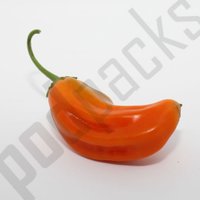Each Pod Pack Contains
Approx 8-11 Pods
Aji Amarillo
Aji Amarillo is also called amarillo chili and ají escabeche and is a member of the capsicum baccatum family of peppers. It origininates in ancient Peru and can be found across the Andean region of South America and has been long associated with Peruvian cuisine. Ají amarillo literally means yellow chili; however, the the mature pods are actually a bright orange colour. This pepper is 30,000 to 50,000 on the Scoville Heat unit scale and is considered part of the Peruvian "holy trinity" when it comes to their cuisine, along with garlic and red onion. But the aji amarillo balances that heat with a bit of fruity flavour. Smelling a bit like a raisin, this chilli's taste is somewhat subtle with hints of passion fruit and mango and imparts a unique flavor to any dish.
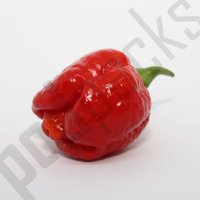
Brain Strain
Capsicum chinense. The Brain Strain pepper was cultivated by chili grower David Capiello. He selectively bred 7 Pot peppers over a course of seasons selecting only “brain-like” traits – pocky, folded, and bulbous pods. The result is a super-hot pepper with a distinct brain-like look, both on the outside and in. Heat levels are reported to be between one million and 1.3 million Scoville Heat Units.
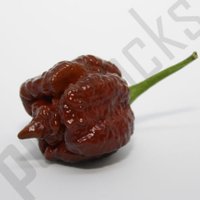
Chocolate Reaper
Capsicum chinense. This natural cross emerged in our glasshouses in 2017 and is available exclusively from ourselves. A chocolate brown version of the world record breaking Carolina Reaper. Rich, fruity flavour combined with intense heat and a fantastic, wrinkly reaperish pod shape. Based on our taste sessions we feel this is approximately 900,000 to 1.2 million Scovile Heat units.
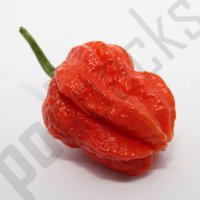
Fatalii Jigsaw
Capsicum chinense. An 'improved' Moruga Scorpion. Improved through selective seed harvesting and crossing with an unknown super-hot. No official Scoville ratings available but we believe the variety to be at least 900,000 Scoville Heat Units.
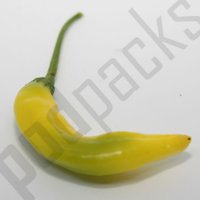
Aji Limon
Capsicum baccatum. This Peruvian variety produces a lovely spicy hot fruit with a lemony zing. Starting off pale green the fruits mature to a bright lemon yellow. Pods measure up to 3" (7.5 cm) long and ½" (1 cm) in diameter and grow upright and outwards on the plant. Fruiting is prolific making this a stunning ornamental variety. Plant is dense and bushy in habit growing to approximately 2 feet (60 cm) tall with a spread of up to 4 feet (120 cm). Heat Level is approximately 40,000 - 60,000 Scoville Heat Units.
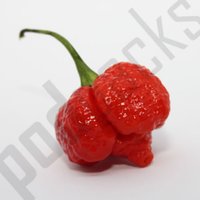
BTR
Capsicum chinense. A cross between the Butch T Scorpion and the Carolina Reaper, it has a nice fruity tone to it with a lot of heat, allegedly as hot as 2.5 million Scoville Heat Units. This variety is one of the few 'stable' super-hot varieties in terms of growing habit of the plant, pod shape, flavour and heat. One of the most special promising of all the varieties we're growing.
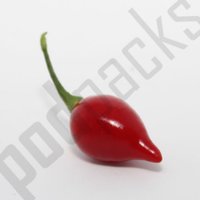
Chupetinho
Capsicum chinense. An extremely rare, heavy-cropping Brazilian chilli that bears small, teardrop-shaped fruit on bushy plants with spreading branches. This pepper is known by many other names such as "pimenta de bico", "biquinho" and "chupetinha" and we estimate the approximate heat level to be between 15,000 – 25,000 Scoville Heat Units. This variety has become famous because of its trademark namesake the “Roquito” pepper. Roquito is not, in fact, a pepper at all but the trademark name for a unique pickled version of the Chupetinho. These sweet, mild, pearl-shaped red gems can be found on pizza's at places like Pizza Express and Prezzo in the UK.
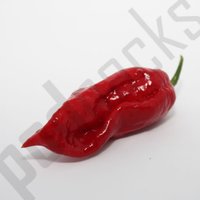
Lava
Capsicum chinense. This is also called the 7 Pot Lava Red. It is a cross between the Moruga Scorpion and the 7 Pot Primo (allegedly) and ferociously hot and fruity in flavour. Probably 800,000 to one million Scoville Heat Units.
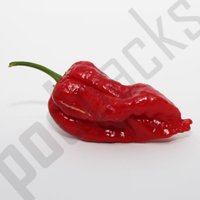
Apocalypse
Capsicum chinense. An extremely hot Scorpion pepper developed in Italy. This pepper is fruity and ferocious and although no Scoville ratings have been made public (to our knowledge) at this time we estimate the heat level is approximately 1.5m Scoville Heat Units. Tipped by some as a 'future' hottest in the world this pepper should be handled with care. The peppers often show a very elongated Scorpion phenotype and the variety, like many of the other super-hots, is unstable and can produce all kinds of contorted shapes / looks!
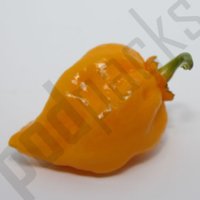
Bubblegum Yellow
Capsicum chinense. 7 Pot Bubblegum Yellow, also called BBG7 Yellow for short or Bubblegum 7 Pot Yellow. This is the Yellow variant of a cross developed by Jon Harper a grower in the U.K dating back to 2012. It is a cross between a red Moruga Scorpion and a Trinidad Yellow 7 Pot. It retains the look of the Moruga Scorpion but ripens to a bright yellow colour which unusually bleeds up the calyx and stem. Some do say it has a slight taste like bubblegum but this is disputed by many chilli connoisseurs. The 7 Pot Bubblegum Yellow doesn't seem quite as hot as the red version but it has citrus and fruity tones similar to other yellow super-hots. Again there's no 'official' Scoville testing available; however, based on our tasting sessions at the ranch we'd estimate the heat level to be between one and 1.5 million Scoville Heat Units on average. The 7 Pot Bubblegum Yellow chile plants grow between 3 to 4 feet tall and bushy.
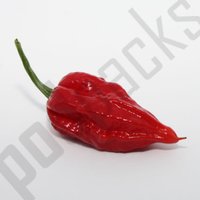
Dorset Naga
Capsicum chinense. Dorset Naga is one of the hottest chillies in the world, capable of reaching a million Scoville Heat Units and more. The scorching heat of the fruit is combined with a distinctive fruity aroma, making this a truly exceptional chilli. The wrinkled, wedge-shaped fruit ripen from green to red, and may be harvested at either stage of maturity. They can be up to 30 x 50mm in size, but may be smaller when the plants are grown in pots. The plants are tall and ungainly, and when grown in the ground or very large pot can reach a height of 1.5m or more. Grown in smaller pots, however, their height can be considerably reduced. Approximate heat level: 544,000–1,221,000 SHU (from tests done on whole crops grown at Sea Spring Seeds). BBC Gardener's World had a single fruit measured at 1,598,277 SHU. This is by far the most consistent of all of the super-hots to grow in terms of heat, flavour, growing-habit and yield.
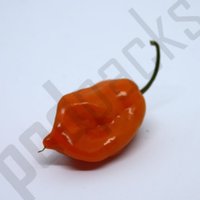
Orange Habanero
Capsicum chinense. Orange Habanero is a combination of beauty and the beast...it is brutishly hot while being seductively fruity. The fruit are thin-fleshed, measure 30 x 50mm and change from green to a stunning salmon orange as they ripen. The medium-sized plants are incredibly productive, and have a tidy growth habit making them ideal for growing in pots or growbags. Orange Habanero lends a distinctive flavour to any dish to which it is added, and it is highly ranked for making a top-of-the-league sweet chilli sauce. 400,000 to 500,000 Scoville Heat Units.
All Pod Packs
Between £4.95 and £9.95
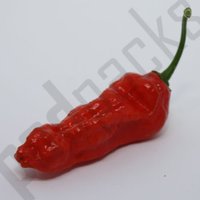
Bhut Jolokia
Capsicum chinense. Also known as ghost pepper, ghost chili, U-morok, red naga, naga jolokia and ghost jolokia. Historically cultivated in the Indian states of Arunachal Pradesh, Assam, Nagaland and Manipur. It is closely related to the Naga Morich of Bangladesh and the many other naga cultivars. In 2007, Guinness World Records certified that the CPI (Chili Pepper Institute) Bhut Jolokia Ghost pepper was named the world's hottest chili pepper, 400 times hotter than Tabasco sauce. The Ghost chili is rated at more than 1 million Scoville heat units (SHUs). However, the ghost chili was shortly superseded by the Infinity chili in 2011, followed by the Naga Viper, the Trinidad moruga scorpion in 2012, and subsequently the current hottest, the Carolina Reaper on August 7, 2013.
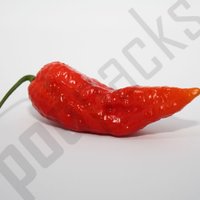
Burmese Naga
Capsicum chinense. The Burmese Naga is a new (to us) open pollinated variety that was found in Burma. We've tasted it and it has a classic naga flavour profile and the heat level is right up there with some of the hottest of the naga's and we'd guess between one million to 1.5 million Scoville Heat Units. Probably the most unique feature of this naga is the pod size which is larger than any of the other naga varieties.
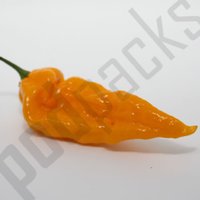
Fatalii
Capsicum chinense. This Habanero from Africa has bright yellow fruits up to 6cm long and 4cm wide produced on a shrubby bush up to 70cm tall x 70cm wide. The fruits are ready to pick at around 100 days after the seedlings have been potted on, and the plant will continue cropping as long as suitable conditions are maintained. The fruits are very hot - from 500,000 to 800,000 Scoville Heat Units.
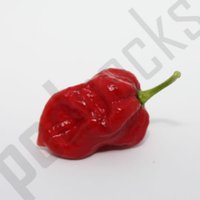
Scorpion
Capsicum chinense. Moruga Scorpion is native to the district of Moruga in at the southern tip of the island of Trinidad. On February 13, 2012, New Mexico State University's Chile Pepper Institute identified the Trinidad Moruga Scorpion as the hottest chili in the world, with a mean heat of more than 1.2 million Scoville heat units (SHUs) and individual plants with a heat of more than 2 million SHUs. According to the Chile Pepper Institute, the previous record holder was the Bhut Jolokia of India. Aside from the heat, the Trinidad moruga scorpion has a tender fruit-like flavor, which makes it a sweet-hot combination. The pepper can be grown from seeds in most parts of the world.

Black Panther
Capsicum chinense. The Black Panther is a cross between Pimienta de Neyde and Bhut Jolokia. A very rare pepper with the telltale purple leaves, stems, flowers and dark purple pods ripening to a rich red. Musky and silk in its flavour this pepper is very hot and although no Scoville testing results have been made public our tastings suggest a possible heat of between 700,000 to 900,000 Scoville Heat Units. Incredibly attractive as a plant and a highly sought-after variety for collectors.
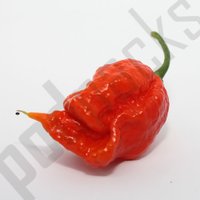
Carolina Reaper
Capsicum chinense. Bred in a Rock Hill, South Carolina greenhouse by Ed Currie, proprietor of the PuckerButt Pepper Company. The Carolina Reaper has been certified as the world's hottest pepper by Guinness World Records since August 7, 2013. The original cross-breed was between a Bhut Jolokia (a former world record holder) and a red habanero, and is named 'Reaper' due to the shape of its tail. The official Guinness World Record heat level is 1,569,300 Scoville Heat Units (SHU), according to tests conducted by Winthrop University in South Carolina. The 'variety' is highly unstable and heat levels vary between 500,000 Scoville Heat Units and 2.2 million. Addiionally, pod-shapes and plant growing-habits vary greatly; however, four years on the Reaper remains the hottest in the world according to Guinness (a beer company).
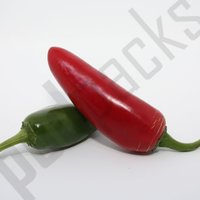
Jalapeño
Capsicum annum. Medium-sized pepper pod type cultivar and one of the most common Mexican varieties. Green ripening to red. 5000 to 10,000 Scoville Heat Units on average. Used widely in Mexican and Tex-Mex cuisine. Traditionally Jalapeno is picked green as red fruits go soft quickly. We often see them pickled on pizza's and nacho's. In Mexico red jalapeno is smoked using a traditional, local wood called mesquite to create chipotle. Chipotle is the Mexican version of smoked paprika and can be used in soups, stews, sauces, salsa's and mole's to add a rich and savory flavour profile.
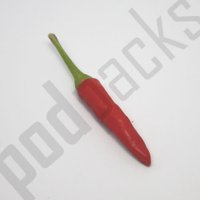
Super Chilli F1
Capsicum annuum. Hybrid. This American variety is attractive and very early, and as chillies go, is one of the easiest to grow. It is also very productive: in our trials we harvested over 300 fruit per plant. The pointed, thin-fleshed fruit of Super Chile are elongated and measure about 10 x 60mm. Changing from light green to red as they mature, they are very hot and are ideal for drying or using fresh to sharpen up your cooking. The short, spreading plants are suited for growing in pots and growbags. Super Chile is definitely worth trying, particularly in areas with a short growing season. It is also the variety of choice for gardeners who intend to keep their chilli plants outdoors. Approximately 20,000 to 50,000 Scoville Heat Units.
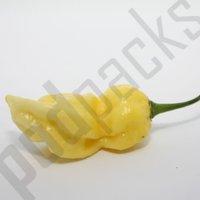
Sugar Rush Vanilla
Capsicum chinense. New variety this year. Meant to be Sugar Rush Peach but all pods are classic capsicum chinense and instead of peach we're seeing a consistent vanilla colouration to the mature fruits. Brand new so we have no heat ratings but our tastings have shown this to be one of the hottest pods this season...potentially 2 or 3 million Scoville Heat Units and a clear contender for the next hottest chilli pepper in the world. Interesting mango and citrus back-tones to the flavour profile and one of the most interesting pods for hot sauce makers since the Lemon Drop.
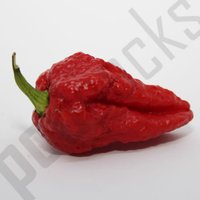
Wartryx
Capsicum chinense. Wartryx is a very rare and sought-after cross between a Trinidad Scorpion, a 7 pod Jonah and an Ubatuba Cambucci as a natural cross. Selective seed harvesting has brought us the Wartryx we know today. The flavour is floral and citrus and one of the hottest of pods we've tried, potentially up to 1.2 million Scoville Heat Units or even more but no test results have been made public.
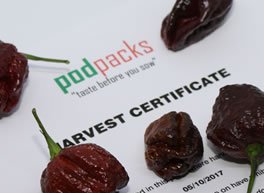
Each Pod Pack is picked to order, and comes with a simple Harvest Certificate to shown what type of pod you have and when it was picked.
Get in Touch
Pod Packs, Edible Ornamentals, Chawston, Bedfordshire MK44 3BL
Phone: 01480 405663
Chilli Tour Guide
Pod Packs is overseen by Award Winning Grower @chillitourguide from Edible Ornamentals
